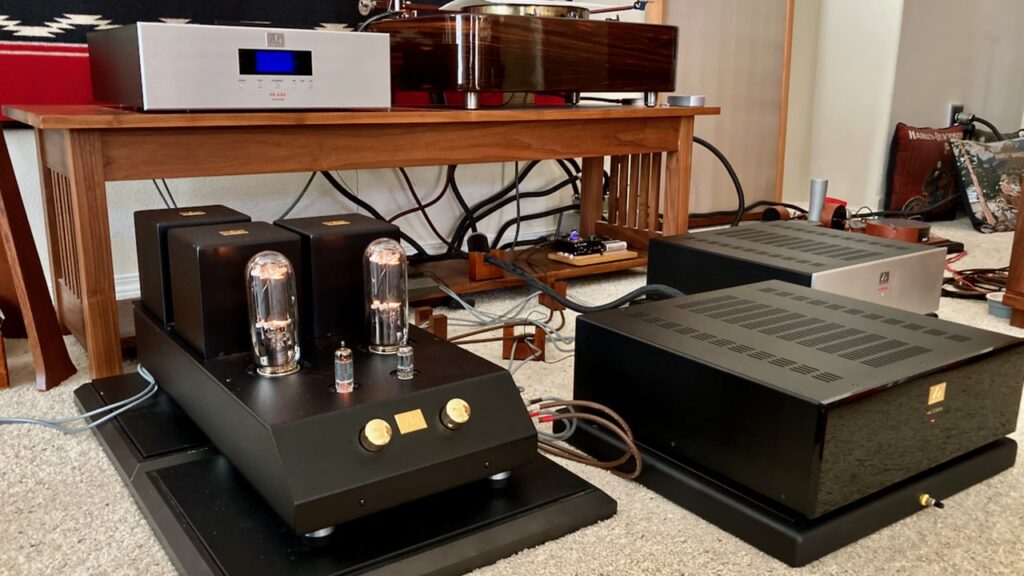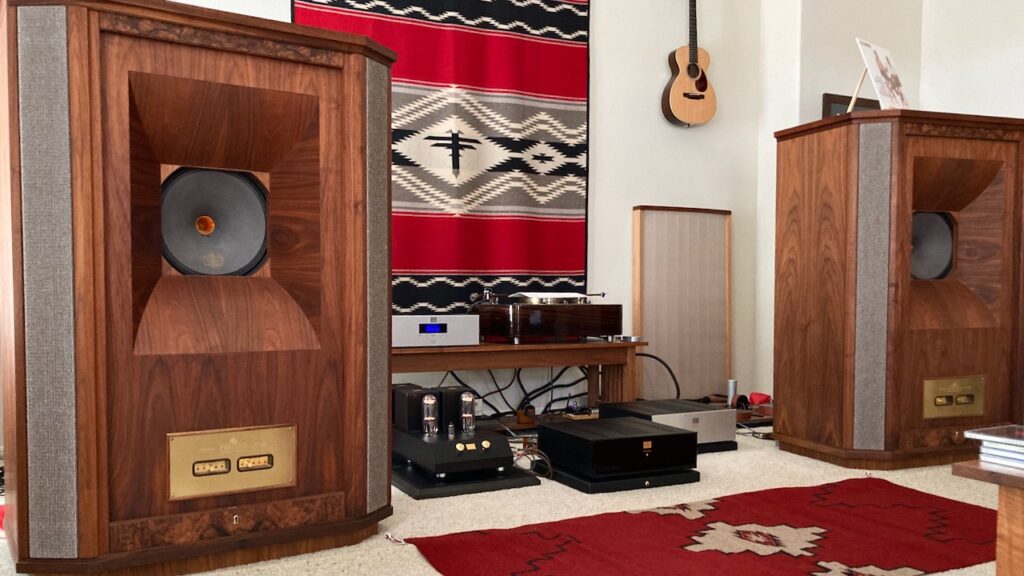Peter Qvortrup (Audio Note (UK)) has been talking with me for a number of years about the need for a revised audio reviewing vocabulary, one that better captures the full span of performance that occurs with *some* high-performance audio components.
I say *some* because until the arrival of Peter's Audio Note (UK) Tomei 211 SET integrated amplifier and M3 RIAA phono stage here at my place, I've never heard the performance aspects with the playback of recordings that these components are capable of revealing, and I've been struggling with how to fully articulate them.
When words fail ... I now get why Peter has been emphasizing the need for an improved audio reviewing vocabulary. It's because the current vocabulary just isn't capable of describing what's happening performance-wise with some components.
It's as if the Tomei & M3 RIAA combination have crashed through what is considered the normal 'audio ceiling' of high-fidelity performance traits to reveal aspects of performance that have been hitherto unheard ... and my usual audio reviewing vocabulary has failed me in trying to articulate those performance traits.
Performance traits beyond musicality terminology, beyond normal 'high-fidelity' audio playback terminology, beyond visuospatial performance, beyond my ability to articulate fully what I'm hearing / feeling / experiencing when listening to recordings of music.
Here's an excerpt of a conversation related to this topic I shared with a group of audio enthusiasts and professional audio designers that are friends of Yazaki-san:
"I get this feeling that I'm hearing & feeling what the musicians intended me to experience from their music, a sort of revelation of their musical message, while at the same time getting deep insights into how the recording was done during its recording era, without the recording's fidelity ever intruding upon the musical experience."
"It's like I'm hearing the combined effect of the artistry of the musical performance, plus the artistry of the recording arts, to hear something new and alive in its own right. It's like hearing through whatever the recorded fidelity was into a realm of tangible musical artistry that is independent of the recorded fidelity. A sense of 'being' for that moment in time, for lack of a better word to articulate the effect."
"It's a little hard for me to articulate this effect fully, but even when listening to lower fidelity recordings like those of the 78 eras of recording, the music just comes alive and transports me into a realm of listening, of being touched by the musical performance, in a way that I haven't encountered before. A transcendent listening experience that makes the artistry of the music become fully alive regardless of the recording era's fidelity & style."
These particular performance traits transcend my normal vocabulary considerations when listening to recordings of music: musicality attributes and high-fidelity audio attributes ... something beyond those aspects is occurring, and I'm keen to figure out how to better articulate it.
What's particularly challenging for me is how to articulate the combination of perception that is the hearing/feeling/experiencing of a recorded musical performance that these components are capable of delivering in my Westminster loudspeakers based audio system.
Have you ever seen in person Vincent Van Gogh's 1889 painting The Starry Night?
A number of decades ago I had the opportunity to view The Starry Night while it was on display in the National Gallery in Washington, D.C.
There's a vivid radiance, a presence, a sense of being, a sense of aliveness, a sense of power, about The Starry Night that can't be experienced from photos of it, you have to see it in person to fully 'get' it, and to be pulled into its reality.
That's kind of like what the Tomei 211 SET amp & M3 RIAA phono stage combination does for listening to recordings, they allow me to be pulled into the 'reality' of the recorded musical performance in a new way.
They allowed the manifesting of a sense of experiencing an 'in-person' sense of artistry, sense of reality, sense of being, sense of aliveness, that each recording of a musical performance possesses, but normally lies hidden behind the 'photograph' of the recording.
It's like they have the ability place me into the realm, the reality, where I am experiencing an artwork firsthand, with all the impact upon one's senses that implies.
It's more than musicality, even though that's present, it's more than normal high-fidelity audio performance, although that's present ... it's just more.
Way back when I was involved in a project to build a new detector for the Belle II experiment - for the SuperKEKB collider in Japan - that was investigating new phenomena beyond the Standard Model of particle physics, and its implications for the studies of rare physics processes, which were out of reach of the previous e+ e− experiments.
I think of the Tomei 211 SET amp in that same vein, as being like a new 'detector' that is able to reveal performance phenomena beyond what the 'Standard Model' of high-fidelity audio performance normally comprises, into a realm that has hitherto been beyond my reach & ability to imagine.
In the world of quantum mechanics reality doesn't function in the ways we are used to, and no one has been able to come up with a complete explanation of the way the world works at the subatomic level.
Take for example, the thought experiment of Schrödinger's Cat, where a cat can be alive and dead at the same time, which Schrödinger designed to illustrate a paradox of quantum superposition.
It's an interesting thought experiment, with some small relevance to audio, where we are enjoying recorded musical performances that are both dead & alive at the same time.
The albums are "dead" in the sense that the musical performances existed in the past, but "alive" in the sense that we can "... feel the vibrations of the air trapped in the grooves of a phonograph record from 100 years ago ..." in our present reality (a beautiful expression of listening to 78 records from an article Paul James shared with me - thanks, Paul!).
Now that's not quite the same as Schrödinger posited, as his thought experiment was about the potential for actual life & death coexisting at the same time (I know, a broad application of Schrödinger's concept).
Consider the Many Worlds Theory of physics that posits that there are many parallel worlds that branch off from each other and that all exist at the same time.
In theory, there could be many parallel universes - the multiverse - and we might be living in one of an infinite number of possible universes. Those universes are posited to all exist around us at the same time, we just aren't able to perceive that they are in fact, all here with us now.
So what is happening when I am listening to recordings of musical performances from all the eras of the recording arts?
With the Tomei 211 SET amp as my detector - this is just an analogy - I feel like I am experiencing an audio multiverse where I am experiencing the sensation of being in multiple parallel audio realities at the same time.
In one parallel reality I am experiencing the actual music performance as it is being recorded - its sense of being - of life flowing along, with all the vivid radiance, presence, aliveness, and sense of emotive power life possesses.
At the same time I am hearing all the traits of the recording arts of any given era, yet they exist in a separate but overlapping parallel reality, that does not diminish that first reality.
It is like the Tomei digs so deeply into the fabric of reality that I experience the essence of a recorded musical performance in a quantum "alive" reality as it was being recorded, yet at the same time I can also observe the nature of the recording and its fidelity in a parallel overlapping reality, the "dead" reality of the recording.
Those two traits of the music being "alive" and the recording being "dead" coexist at the same time in undiminished fashion. It's a truly uncanny sensation, and independent of a recording's overall fidelity, whether high or low.
It makes me feel like I am experiencing multiple audio realities that coexist at the same time, which are temporally and spatially different from the one I normally live in.
I can move into the past, an alternate present, a possible future, all at the same time, into an audio realm beyond, or into just being ... something new.
Ok, so that's my dilemma. How do I come up with an audio reviewing vocabulary that can describe that sort of auditory phenomena?
I'm working on it ...
As always, thanks for stopping by, and may the tone be with you!































